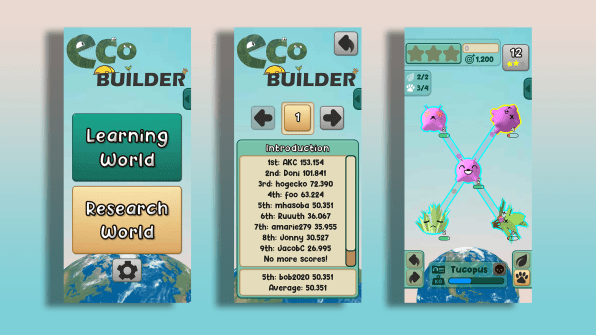Is There A Game That Lets You Make Custom Plants And Animals
Keeping an ecosystem in residue is catchy, especially equally climate change and other human interventions threaten our wildlife, so scientists plough to mathematical models to map out how things such as pollution or population will touch on our world, or how we can salve certain species through conservation work. Now, anyone tin can try their hand at keeping an ecosystem in balance through a new smartphone game, while as well helping researchers notice real-world answers to ecological problems.
Through EcoBuilder, players build their own ecosystems of plants and animals, adding in species of dissimilar sizes and deciding who eats whom. Based on those decisions, the species will either survive or get extinct. The game was developed by Jonathan Zheng, a PhD student at Regal College London's Department of Electrical and Electronic Applied science, and his co-advisors Dan Goodman, a neuroscientist in the aforementioned department, and Samraat Pawar, a biologist within the Department of Life Sciences.

The idea was inspired past a BBC documentary well-nigh the wolves in Yellowstone, which were alleged extinct there in 1926. Without wolves, the ecosystem drastically changed. The number of elk skyrocketed, and so did the corporeality of vegetation that the elk ate. Less of that vegetation affected the habitat for smaller animals such as beaver, and in a chain reaction, even the population of fish struggled.
To bring the ecosystem back into residuum, ecologists reintroduced wolves into the park, which brought downwards the elk population, allowing the plants the elk ate to abound bigger, which allowed beavers to build dams again, which brought dorsum fish. The elk population in Yellowstone is actually higher today than it was when in that location were no wolves, and the predatory threat of wolves keeps the elk moving around the park instead of overgrazing one area, which acquired all those cascading effects. "I plant information technology and so intriguingly counterintuitive, the idea that in club to save the things the wolves swallow, yous take to bring the wolves back," Goodman says. "I loved the idea that you could play effectually with that sort of thinking, that ecosystems tin can bear in a really unusual way."
Though EcoBuilder doesn't depict existent animals—all the plants and animals are fabricated upwardly, like Pokémon—the idea is the same: players add together in predators in order to proceed every species alive. The species in the game differ only in size, which still affects their interactions. When plants are smaller or lighter, they grow faster, feeding more animals. If yous make the plants large like an oak tree, they take besides long to abound for the animals to survive off of. When the animals modify in size in the game, it affects how they consume. "If you imagine a herd of cows eating a field of grass, they're going to eat it a lot lower than a swarm of locusts," Zheng says.

The game uses the aforementioned mathematical models that scientists use to model real ecosystems. With every level a player completes, the best ecosystem they made and the actions they took to get there are stored on a server to exist shared with researchers. "There's a chance that . . . the results that come from the strategies that the players use and similar understanding of real ecosystems could be used to inform environmentalist policies," Zheng says. There are also ecological models that look at how carbon sequestration can impact species diversity, and the designers say a future update of the game volition include a climate modify aspect to see how these systems change as the environment does.
While crowdsourcing enquiry for experts, the game also helps its players learn about dissimilar ecological phenomena, like competitive exclusion or biocontrol. One interesting thing players may realize is how influential pocket-sized and medium-sized species are, Pawar says. A lot of conservation work tends to be influenced past what people similar to report, which ways species such as polar bears may exist overrepresented in inquiry. "The reality, and that feature the game does capture, is that modest to medium-sized species are actually the movers and shakers of ecosystems," he says. Once there are enough players to brand statistically significant observations, Zheng says they'll publish the results from the game, and if you become a high score, your name might even announced in that paper.
Source: https://www.fastcompany.com/90536034/this-mobile-game-lets-you-build-ecosystems-that-will-help-solve-real-world-ecological-problems
Posted by: brittfecid1988.blogspot.com

0 Response to "Is There A Game That Lets You Make Custom Plants And Animals"
Post a Comment